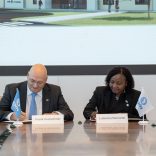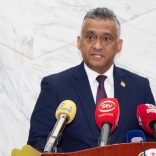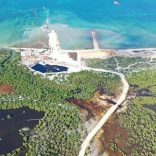Mozambique nears deal to revive $20 billion Total gas project
Mozambique: Cahora Bassa hydropower producer paid the State €1.588B since 2007

Photo: Hidroeléctrica de Cahora Bassa
Hidroelétrica da Cahora Bassa (HCB), Mozambique’s largest electricity producer and one of the main dams in Africa, announced on Wednesday that it has paid €1.588 billion to the Mozambican state since 2007.
Speaking at the opening of the conference marking HCB’s 50th anniversary, the chairman of the board of directors, Tomás Matola, said that HCB had paid the Mozambican state between 2007 – after the reversion from Portugal to Mozambique – and 2024 around 115 billion meticais (€1.588 billion) in concession fees and taxes.
‘In the last two years alone, 2023 and 2024, the company paid the state around 37 billion meticais [€510 million],’ he said.
At the same event, when discussing the role of hydroelectric projects in the development of the regional economy, HCB’s financial director, Ermínio Chiau, said that Mozambique earned US$431 million (€379 million) from electricity exports in 2024, selling to South Africa’s Eskom Holdings SOC Ltd and Zambia’s Zesco.

“In 2020, sales enabled the repayment of US$354 million [€312 million], which in terms of export weight in the sector constituted 78% (…). These foreign exchange earnings dictate the strengthening of the balance of payments, exchange rate stability, as well as an increase in credit capacity for the economy,” said Ermínio Chiau.
The producer again acknowledged challenges in electricity production and marketing due to low rainfall, culminating in reduced water storage levels, but said it was making ‘every effort’ to ensure production.
“Our vision, our strategic plan, is to achieve a production of 4,000 MW by 2034, to make HCB one of the largest energy producers in Africa,” said HCB chairman of the board, Tomás Matola.
Electricity production in Mozambique is expected to fall by 1.3% in 2025 due to maintenance work at the hydroelectric plant, the country’s largest producer and one of the main dams in Africa, according to government forecasts.
According to official government data consulted on Wednesday by Lusa, with estimates for 2025, “a decrease in electricity production of around 1.3% is expected, influenced by the need for maintenance of generators and the reduction of the hydrological cycle” at HCB, “which represents around 78.7% of the production and export structure”.
As a result, Mozambique is expected to produce 19,197.8 gigawatt hours (GWh) of electricity this year, with 15,504.4 GWh guaranteed by HCB in the central province of Tete, a reduction of 4.1% compared to 2024 and the lowest figure in four years.
Overall, electricity production from hydro sources, including the Cahora Bassa dam, is expected to decline by 4.1% this year, while electricity production from thermal power plants is expected to increase by 17.6%, almost half of which will come from the Ressano Garcia natural gas plant, which is expected to guarantee 1.196.3 GWh in 2025, 7.4% more than in 2024.
HCB is 85% owned by the state-owned Companhia Elétrica do Zambeze and 7.5% by Portugal’s Redes Energéticas Nacionais (REN), with the company holding 3.5% of its own shares and the remaining 4% in the hands of Mozambican citizens, companies and institutions.
The Cahora Bassa reservoir is the fourth largest in Africa, with a maximum length of 270 kilometres and 30 kilometres between banks, occupying 2,700 square kilometres and an average depth of 26 metres. It employs almost 800 workers and is one of the largest electricity producers in southern Africa, supplying neighbouring countries.
The dam is located in a narrow gorge of the Zambezi River and its construction took place from 1969 to 1 June 1974, during the Portuguese colonial period, followed by the filling of the reservoir. Commercial operation began in 1977, with the transmission of the first 960 MW, produced by three generators, compared to the current installed capacity of 2,075 MW.












Leave a Reply
Be the First to Comment!
You must be logged in to post a comment.
You must be logged in to post a comment.